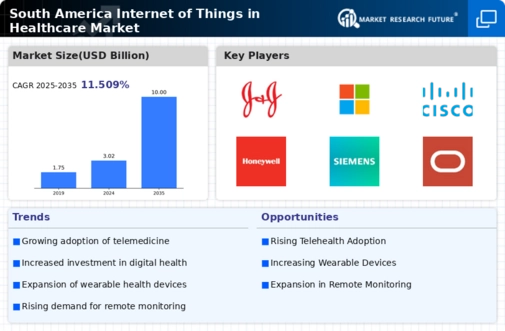The internet of-things-in-healthcare market in South America is characterized by a rapidly evolving competitive landscape, driven by technological advancements and increasing demand for efficient healthcare solutions. Key players such as Philips (NL), GE Healthcare (US), and Medtronic (US) are strategically positioning themselves through innovation and partnerships. Philips (NL) focuses on enhancing patient outcomes through connected health solutions, while GE Healthcare (US) emphasizes digital transformation and data analytics to improve operational efficiency. Medtronic (US) is leveraging its expertise in medical devices to integrate IoT technologies, thereby enhancing remote patient monitoring capabilities. Collectively, these strategies contribute to a dynamic competitive environment, fostering innovation and collaboration among market participants.
In terms of business tactics, companies are increasingly localizing manufacturing and optimizing supply chains to enhance responsiveness to regional demands. The market structure appears moderately fragmented, with several players vying for market share. However, the influence of major companies is substantial, as they set industry standards and drive technological advancements. This competitive structure encourages smaller firms to innovate and differentiate their offerings, thereby enriching the overall market landscape.
In October 2025, Philips (NL) announced a partnership with a leading South American hospital network to implement its advanced telehealth solutions. This strategic move is likely to enhance patient access to healthcare services, particularly in remote areas, while also positioning Philips as a leader in the telehealth segment. The partnership underscores the importance of collaboration in expanding market reach and improving healthcare delivery.
In September 2025, GE Healthcare (US) launched a new AI-driven analytics platform aimed at optimizing hospital operations and patient care. This initiative reflects GE's commitment to integrating artificial intelligence into healthcare, potentially transforming how healthcare providers manage resources and patient data. The introduction of this platform may enhance operational efficiencies and improve patient outcomes, thereby solidifying GE's competitive edge in the market.
In August 2025, Medtronic (US) expanded its remote monitoring capabilities by acquiring a local IoT startup specializing in wearable health technology. This acquisition is indicative of Medtronic's strategy to enhance its product portfolio and leverage innovative technologies to improve patient care. By integrating wearable devices into its offerings, Medtronic is likely to strengthen its position in the growing market for remote patient monitoring solutions.
As of November 2025, current trends in the internet of-things-in-healthcare market include a strong emphasis on digitalization, sustainability, and the integration of AI technologies. Strategic alliances are increasingly shaping the competitive landscape, as companies recognize the value of collaboration in driving innovation. Looking ahead, competitive differentiation is expected to evolve, with a shift from price-based competition to a focus on technological innovation, supply chain reliability, and enhanced patient outcomes. This transition may redefine market dynamics, compelling companies to invest in cutting-edge solutions that address the evolving needs of healthcare providers and patients alike.


















Leave a Comment